In memoriam: Stanton Gill
What a shock to hear that Stanton Gill, much-loved professor of entomology at the University of Maryland, passed away unexpectedly on October 6 at the age of 72. I will admit to being a bit surprised to learn he was 72 ... his sense of humor and energy placed him 10 years younger than that.
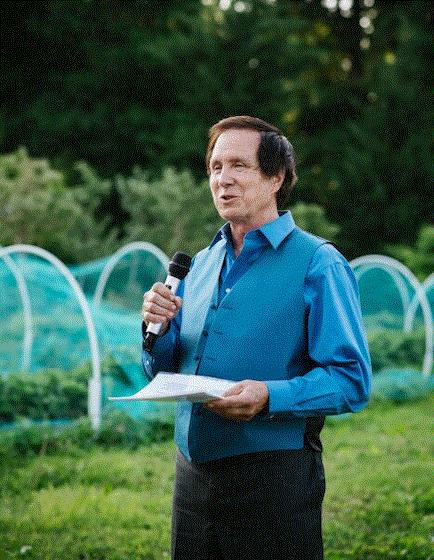
Stanton was a distinguished entomologist and an icon in the cut flower industry, and he loved the opportunity to share his passions of research and education, working with the University of Maryland at the Central Maryland Research & Education Center (CMREC) for nearly 50 years. Stanton was an integral part of establishing the Montgomery College Landscape Technology two-year associate’s degree program where he took his students beyond the classroom by passing on real-world practical experiences to expand his students’ skills and abilities.
He expanded his horizons and understanding of the sciences he taught by purchasing farmland and establishing an extensive orchard operation at his beloved MacBride and Gill Falcon Ridge Farm. This proved to be an unexpected learning experience for Stanton, who often commented that his understanding of all things agricultural was greatly enhanced by his hands-on efforts at his farm. His successful venture in fruit growing led him to be a long-time and well-known vendor at the Olney Farmers Market, along with several other markets.
Stanton is survived by his wife Nancy, his two daughters, Chelsey and Kelly (Kentaro), his sister Rose Mary (Ed), and his brother David (Sandy).
The family is establishing a scholarship in Stanton’s honor for the Montgomery College Environmental Horticulture Program. In lieu of flowers, contributions can be made HERE. Select “Give to where the need is greatest,” then note that this is a memorial gift in honor of Stanton Gill.
I worked with Stanton on many occasions. In fact, he was the first person to invite me to speak at an industry event, way back around 1995 or so. I must have done okay, as he invited me back to at least a half dozen events in Maryland to speak. So thank you, Stanton, for forcing me to get over my shyness!

Beekenkamp, Dümmen Orange “explore closer collaboration”
That is the vague way in which this week’s press release presented the info that two of Europe’s largest flower breeding companies may be hooking up or partnering in some way, shape or fashion. They are in talks to “explore opportunities for a closer partnership in marketing & sales, R&D and production,” and, in fact, An Beekenkamp and Anthony Christiaanse, the respective CEOs of Beekenkamp Group and Dümmen Orange, have signed a letter of intent to that end.
Letter of intent … hmmm. According to Google’s AI, a letter of intent (LOI) “is a non-binding document that outlines the agreement in principle between two or more parties before a formal agreement is finalized. LOIs are often used in business transactions, such as mergers and acquisitions, joint ventures and real estate leases.”
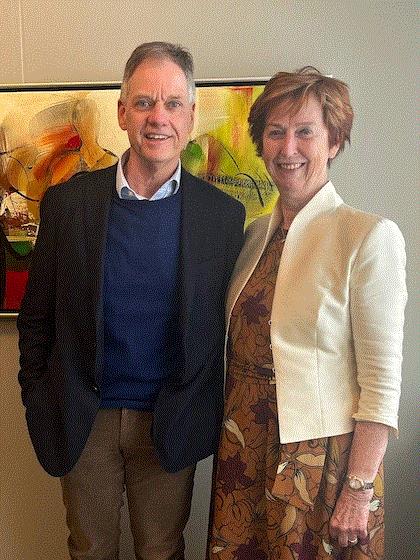 Anthony and An ... headed toward a business deal? Seems that way.
Anthony and An ... headed toward a business deal? Seems that way.
Another hint in the press release is a quote from An: “The breeding industry for flowers and plants is at a pivotal moment, where collaboration can drive innovation and efficiency. Strategically, we want to grow by acquisitions. We believe that a partnership between Beekenkamp Group and Dümmen Orange can create significant value for our companies and our customers.”
I added the italics above.

Beekenkamp and Dümmen Orange (continued)
For his part, Anthony added, “Deepening the partnership with Beekenkamp Group presents a tremendous opportunity to better leverage the considerable strengths of both companies. By sharing our knowledge and experience, we can respond to market demands more effectively and serve our customers worldwide more efficiently.”
To see if I could get any more clarity, I spoke with Sirekit Mol, head of commercial operations for Beekenkamp. While she admitted the release was vague, she said its intent was to “avoid speculation” as leaders of the two companies visit each other’s locations.
“We are really in the exploring stage at the moment,” Sirekit said. “… trying to visit each other, looking at different locations, the work of different departments … so they are basically still getting to know each other in that aspect.”
She said the phrase "potential collaboration" is because nothing is set yet and anything can happen.
“It’s really because they believe collaborating and sharing knowledge are definitely essential for the long-term.”
Another possible hint Sirekit offered: “Beekenkamp would like to stay a family business,” as Beekenkamp is a family business and Dümmen Orange has not been a family business since the Dümmen family sold their remaining shares to new private equity owners in 2015.
As for a time frame for this exploration, Sirekit could only say there isn’t one.
To recap the players in this drama, Beekenkamp Group is a Dutch family-owned company active in plants (both vegetables and ornamentals), packaging, and R&D for ornamentals and chrysanthemums (through their division Deliflor). Dümmen Orange is a leading breeder of cut flowers, potted plants, bedding plants and calla lilies.
The two already have a history of partnering, namely in the rooting of chrysanthemums for Europe.
Oh, and lest we forget: the sales brokerage firms McHutchison and Vaughan’s Horticulture are part of Dümmen Orange, too, so if and when there's an acquisition, Beekenkamp will get those as well.
Stay tuned!

True Value files Chapter 11; plan to sell to Do It Best
Maybe I’m part of the problem: I always go to Ace.
News is out that True Value Hardware has filed for Chapter 11 bankruptcy and is aiming to be sold by the end of the year to rival hardware retailer Do It Best.
This is where it gets confusing: The 4,500 True Value retail stores are independently owned and operated and are not part of the bankruptcy. They’re fine; it’s the wholesale supplier side of the business, which says it will continue to supply those retailers.
True Value—which sells hardware, tools, lumber, plumbing, heating supplies and other home improvement goods—has between $500 million and $1 billion in total liabilities, according to its Chapter 11 petition in Delaware bankruptcy court.
Chris Kempa, True Value’s CEO, said, “After a thorough evaluation of strategic alternatives, we determined that the sale of our business was the path forward to maximize value and best serve our retail partners and other stakeholders into the future … We believe that entering the process with an agreed offer from Do it Best, who has a similar decades-long history in the home improvement space and also operates with a focus on supporting members and helping them grow, is the most beneficial next step for True Value and our associates, customers and vendor partners.”
Do It Best agreed to pay $153 million in cash, take on about $45 million in contracts and other obligations, and hire some True Value employees. Based in Fort Wayne, Indiana, the hardware, lumber and building materials cooperative serves more than 4,300 independent stores in all 50 U.S. states and more than 50 countries.
Are any of you retailers affiliated with either of these hardware buying groups? Does the news mean anything of significance? Let me know HERE.
If I don’t answer right away it’s because I’m at Ace.

Milton … and his tornadoes
While Helene skirted the west coast of Florida and only sent gusts and squalls over east-central Florida where I reside, Milton took a direct path across the state, entering Florida south of Tampa, passing just below me and Orlando, and exiting into the Atlantic at Cape Canaveral. The winds weren't as bad as expected—46 mph continuous with gusts in the 80s mph. But unless you were right on the Gulf Coast of the state where Milton made landfall, it was tornadoes that caused the bulk of the damage to homes and businesses—including greenhouse operations.
After seeing I dodged a bullet in east Orlando, I started putting feelers out about my friends in the Florida industry. Quickly, I learned that the Ft. Pierce location of Brad’s Bedding, owned by Bradley Bethurem, was “completely destroyed” by a tornado, he said. Ft. Pierce is on the Atlantic side, 100 miles south of Cape Canaveral, well out of the path of the hurricane, and so should have not had any issues but a few tree branches. Alas, that was not the case.
The nursery was a near total loss, along with the fall bedding crops and poinsettias. Brad told me he lost about 75,000 poinsettias, plus hundreds of thousands of liners and 4-in. pots of Sunpatiens, New Guineas, geraniums and other annuals—about $1.5 million in product total. Wrote Brad with obvious frustration, “I’m just worn out with this business.”
I replied I didn’t blame him one bit—this business is hard enough when it’s easy!
I had plans to drive down and see him, and bring Snoopy the drone to capture images of the damage from above, but the day I was scheduled to visit it was just too windy for flying. Brad has his own drone, however, and shared the following shots:

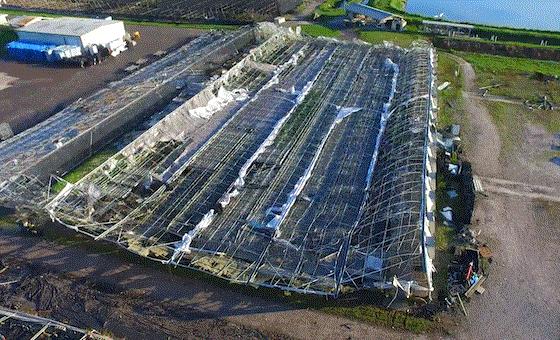
He also shared video from his security cameras. They clearly show a tornado shredding poly and shadecloth … the wind whips, debris is flying everywhere, everything turns dark gray, and when the storm recedes into the distance, you can see the resulting damage.
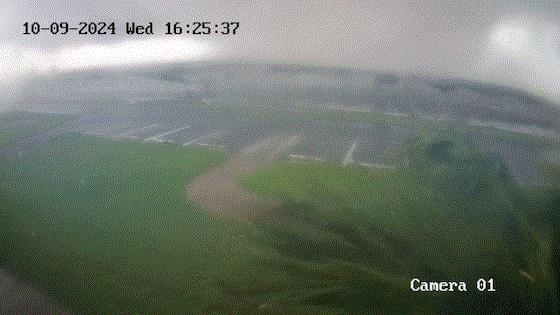
The dark gray mass of the tornado as it flattens the structures in the previous photos.
Here is a before and after from another camera, which was aimed at the greenhouse in the second photo:
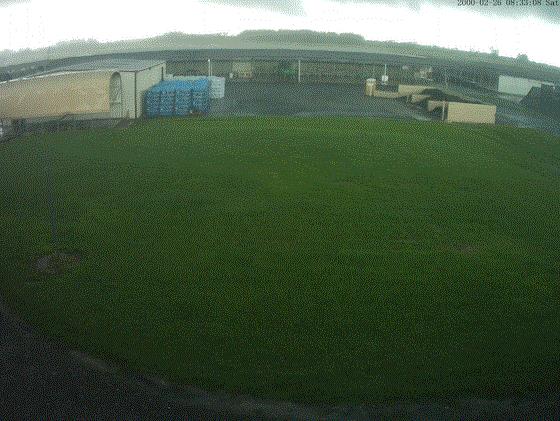
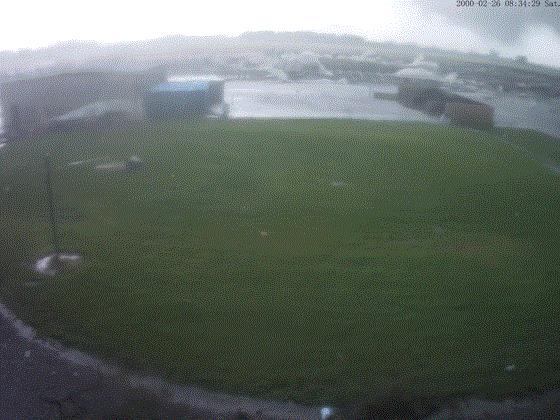
On the bright side, Brad has two locations; his main one, in Delray Beach, is another 100 miles south and was unscathed. Also, with the forecast of a heavy hurricane season likely, Brad went “all in” on crop insurance for both locations, spending some $220,000 in premiums (the majority for his larger Delray Beach location). He’s also hoping for some Hurricane Indemnity Program (HIP) moneys to help rebuild.

More damage
More proof of how hard this business can be is Orban’s, whom I wrote about last time, after Hurricane Helene. Located on the Gulf Coast in Bradenton, Orban's took an almost direct hit this time. There was little left for the water to take away; the winds, however, took out part of what looks to be a production barn. A few days earlier, more than 200 generous volunteers had shown up to help owner Tyler Orban and his staff clean up the muddy mess left by Helene.
Fox News interviewed Tyler on the news show "American Reports." He told anchor John Roberts, “We’re going to keep it going. It’s going to be a challenge, though. The first storm pretty much wiped out our entire crop and then the second one did a ton of damage on our structures.”
He said they lost part of a newly rebuilt barn, the entire office and any sheds they had on the property. “We’ve got a lot of work to do and, unfortunately, not a lot of product to sell, so it’s going to be a challenge. But we’re going to push through it.”
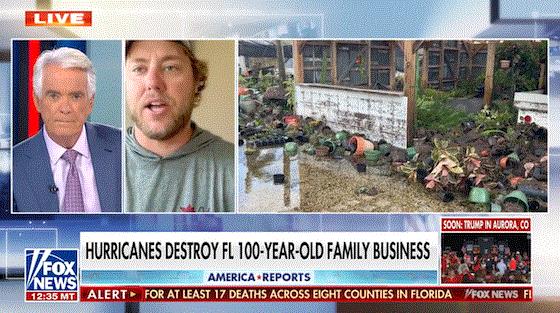
If that doesn’t exemplify the positive, optimistic, never-say-die spirit of most growers, nothing does. Tyler, you’ve got this!
I've also heard, but not confirmed, that Altman Specialty Plants’ Loxahatchee location (just west of West Palm Beach) suffered some damage. Again, way out of the hurricane’s path and so completely unexpected.
Closest to me was Central Florida Ferns & Foliage. I dined with general manager Matt Roberts Sunday night as part of a TPIE group meeting. I saw him again eight days later in Zellwood, next door to Apopka, about 45 minutes from my house, to survey a greenhouse flattened by a tornado or microburst. He said he came up the drive, saw one house with just a bit of flapping plastic, thought that was all he was going to have to clean up, then came around the corner to find this:
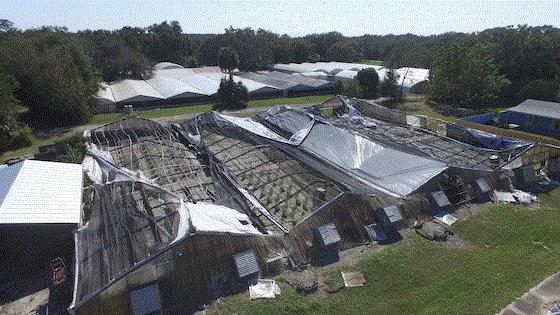
Matt was lucky on three counts: He has three other locations nearby to pick up the slack; this house had already been slightly damaged by Helene and so they had started moving the crop; and the house is pretty ancient (1970s) and was slated for replacement in 2025. Joked Matt via email when he told me about the damage, “Mother Nature just sped up our timeline.”
Got any hurricane stories to share—including the good stuff about industry and community coming to the rescue? Email me HERE.

From the Plug & Cutting Conference
I’ve been remiss in not sharing a bit of what I learned while guiding my bus full of growers on the Plug & Cutting Conference pre-tour.
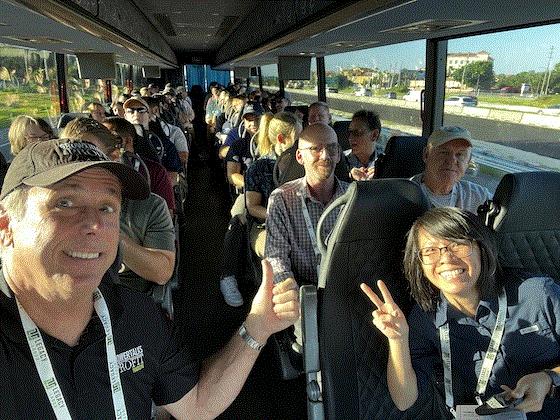
There were three buses of about 150 folks out for the day. There were six tour locations total: tissue culture labs AG2 and Agri-Starts, foliage producer Costa Farms (one of their Exotic Angel plant production facilities), tropical young plant producer Deroose Plants, and plug and finished plant grower Knox Horticulture. Each bus visited three or four of those. Here are a few notes about what my group saw at our three stops:
Knox Horticulture
Fall is a slow time for plugs at Knox, although they had enough on hand to give a good demonstration of production and shipping to the visitors. What they had most of, however, was poinsettias—about 115,000 of them, from 4.5 in. to 10 in. These are florist grade, said GM Steve Mullen, for higher-end customers like resorts and fundraisers.
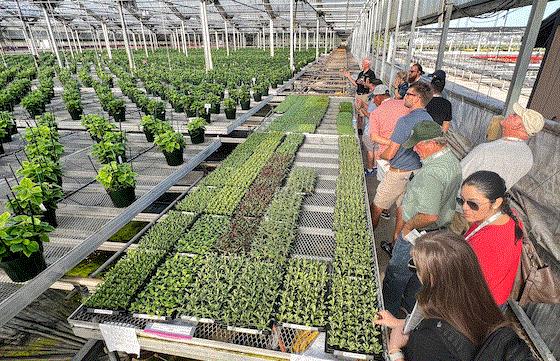
Something else we saw: Some years back, Knox put in Nexus retractable-roof greenhouses. They’ve since converted them to rigid glazing. However, they did retain some sections of open roof curtains for ventilation. It seems to combine the best worlds of secure rigid glazing and good ventilation.
Agri-Starts
If you want to know how modern tissue culture is done in the U.S., visit Agri-Starts, one of the pioneers in the technology. It was founded in 1984 by Randy Strode; his son, Ty, now runs the day-to-day operations of the family business.
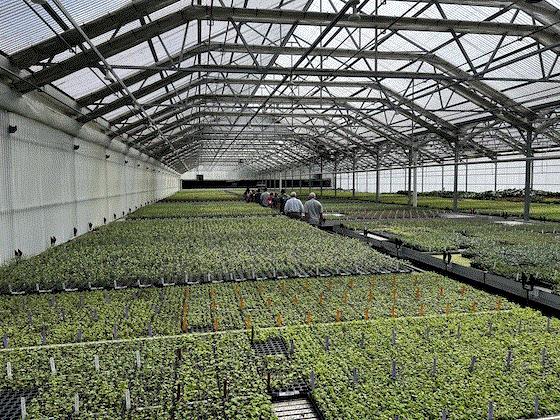
Agri-Starts does 1,100 lines items in more than 100 genera, all from their own TC lab.
We got to see their new lab, which was designed with big exterior windows to allow folks to get a good look at the TC action without risk of contamination. It features 60 hoods, plus eight more for mother stock management. Interestingly, instead of closed grow chambers, all the TC containers reside right behind the technicians in the main room, which Ty said keeps the techs intimately involved with their crops as they grow. (I tried to photograph through the glass, but the sun was in the wrong spot and there was a ton of glare.)
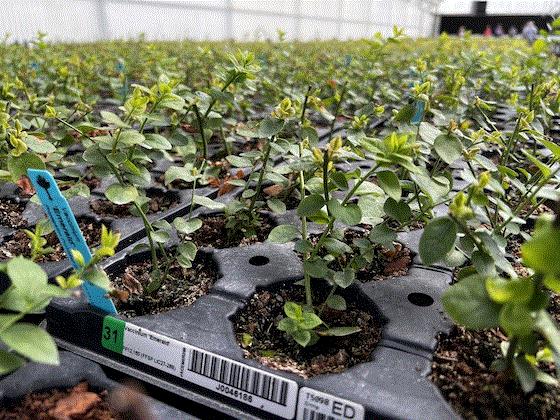
Blueberry liners, one of more than a dozen edible crops Agri-Starts now produces from tissue culture.
The big change Ty has brought to the business is edibles. It started small, but now makes up 50% of their output—which totals 18 million TC plantlets and 15.5 million stage 4 liners. Blueberries are a key crop, with some 80 cultivars.

Costa Farms
The location we visited has a long and storied past: Costa acquired it from Kerry’s Bromeliads; Kerry got it from Fernlea of Canada; Fernlea got it from Natural Beauty/Greiling Farms; Greiling bought it from A. Duda & Sons; Duda picked it up from Ralston Purina, who got it from Green Thumb, which started as United Horticulture in 1970 … which was originally three family nurseries in the same general location. Whew! I remember my first visit here, in about 1994; my tour guide was none other than Arlis Greiling herself!
While the million sq. ft. of glass greenhouses is historical and older, it still will grow a great crop, as evidenced by the vast selection of foliage we saw, of which they ship 250,000 to 300,000 per week. They also bring in pre-spiked orchids for finishing. They’ll ship about 10,000 of these a week.
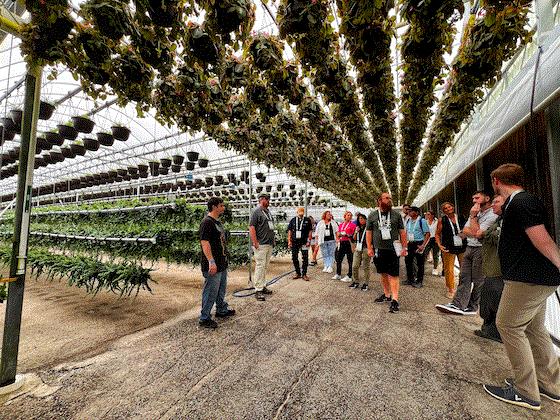 Head grower Zev Zahav talks hanging baskets with the tour. This is a newer section.
Head grower Zev Zahav talks hanging baskets with the tour. This is a newer section.
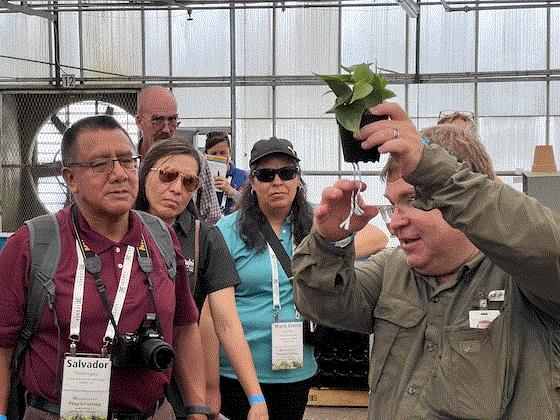 Steve Wolfe showing how WaterWicks (exclusive to Lowes) are inserted into pots before shipping.
Steve Wolfe showing how WaterWicks (exclusive to Lowes) are inserted into pots before shipping.

Easter lily crop looks good!
In contrast to last week’s bad news about the Dutch tulip crop, there's good news on the Easter lily bulb front: the 2025 crop looks good!
I spoke recently with Jim Kennedy, Ball Seed’s commercial director, because he always seems to be on top of the supply of crops that go through Ball. Jim says he's heard that—so far at least—the bulbs appear to be in “very good” condition, and producers feel optimistic about the quality and development of the bulb. About 25% of the crop has been harvested thus far and those that have been analyzed indicate that the bulbs are ahead of last year in development of scale count—a positive indication on leaf count and subsequent bud count for the finished plants.
Based on the bulbs’ development, growers may have some extra time in the schedule and be able to run the crop cooler in January, which will increase leaf count and bud count, thanks to the late Easter (which is April 20, 2025).
For growers doing pot cooling, there should be time for bulbs to root in before cooling.
Looks like good news for those of you still growing Easter lilies!

What about caladiums from Central Florida?
Another crop—grown from tubers, not bulbs—that's also subject to weather during field production is caladiums. With two hurricanes hitting Florida in two weeks, I checked in with Lake Placid, the Caladium Capitol of the World, where something like 95% of the world’s caladiums come from, and long-time grower Bates Sons & Daughters to see how the upcoming crop is faring.
“The crop continues to look great,” replied Terri Bates enthusiastically. “We received less than 2 in. of rain and the winds didn’t cause any damage. It is late in the growing season and we already have tubers forming in the ground. Looking forward to another excellent crop—woo-hoo!”
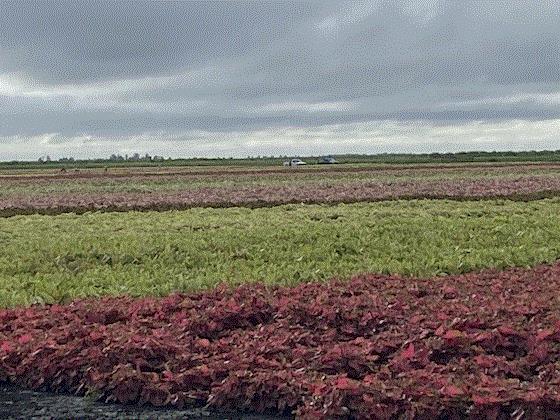
Woo-hoo, indeed! Good news considering the damage past hurricanes have inflicted on the Lake Placid region.
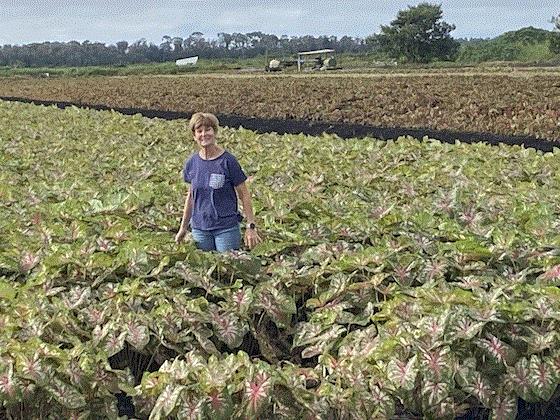 Terri’s sister Sheri out standing in her field. Photos courtesy of Terri Bates.
Terri’s sister Sheri out standing in her field. Photos courtesy of Terri Bates.
Another big Florida caladium producer (actually, the biggest in the world, they say) is Classic Caladiums, a division of Dallas-based Abbott-Ipco. I spoke with the owner of Abbott-Ipco, Marvin Hollander, son of the late Harry Hollander, founder of the company, and brother of the late Richard Hollander.
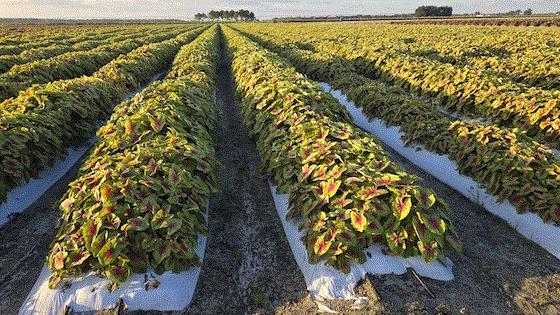
Caladium Lemon Blush, looking good at Classic's Zolfo Springs farm.
Marvin told me he had just talked with his farm manager, Gary Henderson. “Gary defined our crop as the best he’s ever seen,” he said.
Marvin says Hurricane Helene was minimal, with 30 mph winds—“which is just a good stormy day for us.” With Milton, most of the heavy rains and high winds were on the northern portion of the eye, which passed above Classic.
“We came out of there unscathed, thank God, and we’re looking to be producing one of our best crops.”

While we’re at it, holiday greens
Knowing I’d relocated to Orlando from Chicago recently, Shannon Kuhrt, VP of M&M Wintergreens of Cleveland, Ohio, emailed after Hurricane Milton to make sure we hadn’t been blown into the Atlantic or Gulf or something. After assuring her that we were high and dry, I took the opportunity to write, “Hey, while I have you: What is the Christmas greens outlook for 2024?” Her reply was positive:
“The outlook on Christmas is really good! I have not heard of any shortages (except maybe some of the Florida greens that we carry ... still waiting on a feedback report on that). And even with the economy and the election year, the horticulture companies seem to be placing orders and planning for business as usual. A few of my customers were devastatingly impacted by Helene, but are recovering and rebuilding and still doing the holiday season.
“We have the first fresh greenery truck arriving Monday so we are just at the beginning of the product cycles. I am feeling very positive and so are our customers!”
Glad to hear it, Shannon! Anyone out there have anything else to report about the holiday greens business and its outlook? Let me know HERE.

Finally …
What’s that? Pumpkin spice in the air? That must mean it’s nearing time for the Fall River Ridge Report, which I conduct every year right around Halloween. This year, riding shotgun and wielding the sacred River Ridge Report clipboard will be none other than GrowerTalks Editor Jen Zurko, with publisher Paul Black at the wheel. They’ll collect the data, snap photos, send it all to me and I’ll crunch the numbers and let you know how fall gardening and decorating went in my old neighborhood.
Somebody asked recently if I was going to start surveying my new neighborhood, Wedgefield.

Um ... no.
Feel free to email me at beytes@growertalks.com if you have ideas, comments or questions.
See you next time!

Chris Beytes
Editor-in-Chief
GrowerTalks and Green Profit
This e-mail received by 28,954 loyal readers!
Thanks to my loyal sponsors, who help me reach the 28,891 readers of Acres Online in more than 60 countries. Want to be one of them (a sponsor, that is)? Give Kim Brown a shout and she will tell you about our many advertising opportunities.